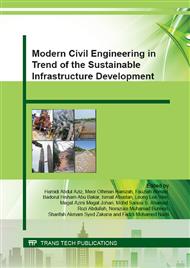[1]
S.K. Thiruvangodan, Waste Tyre Management in Malaysia, Master Thesis, Universiti Putra Malaysia, (2006).
Google Scholar
[2]
N. Ali, A. Amos, and M. Roberts, Use of Ground Rubber Tires in Portland Cement Concrete, Proceedings of the International Conference on Concrete. London, United Kingdom, Thomas Telford Services Ltd, (2000).
Google Scholar
[3]
M.A. Ismail and H. Hashim, Palm Oil Fiber Concrete, The 3rd ACF International Conference, ACF/VCA, (2008).
Google Scholar
[4]
A. Neville, Properties of Concrete. Fourth and final edition standards: Pearson, Prentice Hall. ISBN 0-582-23070-5, (1996).
Google Scholar
[5]
American Society for Testing and Materials, ASTM C150: Standard Spesification for Portland Cement, West Conshohocken, PA, (2012).
Google Scholar
[6]
American Society for Testing and Materials, ASTM C33: Standard Specification for Concrete Aggregates, ASTM International West Conshohocken, PA, (2004).
Google Scholar
[7]
F.N.A. A Aziz, S. M. Bida, N.A.M. Nasir, & M. S. Jaafar , Mechanical Properties of Lightweight Mortar Modified with Oil Palm Fruit Fibre and Tire Crumb. Construction and Building Materials, 73, 2014, 544-550.
DOI: 10.1016/j.conbuildmat.2014.09.100
Google Scholar
[8]
De La RILEM, RILEM CPC-18; Measurement of Hardened Concrete Carbonation Depth, (1988).
Google Scholar
[9]
T.A. Harrison, et al., Experience of Using the prTS 12390-12 Accelerated Carbonation Test to Assess the Relative Performance of Concrete. Magazine of Concrete Research, 64(8) 2012, 737-747.
DOI: 10.1680/macr.11.00162
Google Scholar
[10]
C.F. Chang, and J.W. Chen, The Experimental Investigation of Concrete Carbonation Depth, Cement and Concrete Research, 36(9), 2006, 1760-1767.
DOI: 10.1016/j.cemconres.2004.07.025
Google Scholar
[11]
P.A. Claisse, H.I. El-Sayad, and I.G. Shaaban, Permeability and Pore Volume of Carbonated Concrete, ACI Materials Journal, 96(3), (1999).
Google Scholar
[12]
A. Paillere, M. Raverdy and G. Grimaldi, Carbonation of Concrete with Low-cCalcium Fly Ash and Granulated Blast Furnace Slag: Influence of Air-Entraining Agents and Freezing-and-Thawing Cycles. ACI Special Publication, 91, (1986).
DOI: 10.14359/6013
Google Scholar
[13]
P.K. Mehta, Concrete. Structure Properties and Materials, (1986).
Google Scholar
[14]
K. You, H. Jeong and W. Hyung, Effects of Accelerated Carbonation on Physical Properties of Mortar, Journal of Asian Architecture and Building Engineering, 13(1), 2014, 217-221.
DOI: 10.3130/jaabe.13.217
Google Scholar


